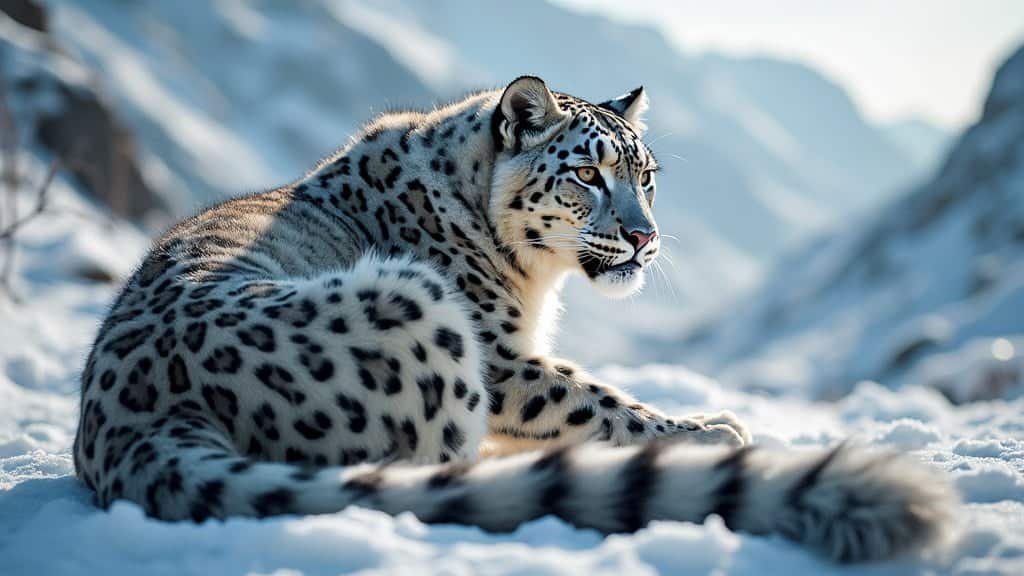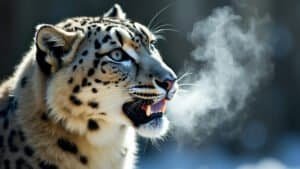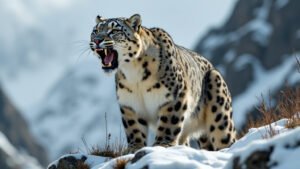Introduction
Snow leopards, known for their elusive nature and ability to thrive in harsh, freezing environments, possess remarkable adaptations that allow them to maintain their body temperature in extreme cold
This article explores the critical role of their dense fur, long bushy tail, and specialized paws in temperature regulation. We will also delve into their physiological adaptations, such as metabolic rate adjustments, and the behavioral strategies they employ to conserve heat
By understanding these unique features, we gain insight into how these magnificent creatures survive and flourish in some of the world’s most unforgiving landscapes
How Snow Leopards’ Fur Helps Regulate Body Temperature
Snow leopards are perfectly equipped to survive the extreme cold of their mountainous habitats, thanks largely to their incredibly dense and insulating fur
This fur not only provides essential warmth but also plays a crucial role in maintaining a stable body temperature, even when temperatures plummet far below freezing. By examining the structure and function of their fur, we can better understand how this majestic predator endures such harsh conditions
Thick and Dense Fur as Insulation
One of the most critical adaptations that allow snow leopards to survive in frigid environments is their exceptionally thick fur. Snow leopards possess one of the densest fur coats of all the big cats, with approximately 3,000 hairs per square centimeter. This fur consists of two layers: the dense underfur and the longer, coarser guard hairs
The underfur is soft and provides crucial insulation by trapping a layer of air close to the skin, which acts as a barrier against the cold. Meanwhile, the guard hairs, which are water-resistant, protect the underfur from snow and moisture, ensuring that the insulation remains effective
The density of the fur varies across the body, with the thickest fur found on the belly and sides, which are most vulnerable to the cold when the snow leopard lies down or curls up. This distribution of fur helps maintain warmth across the body, particularly in areas that are more exposed to the cold
Role of Underfur and Guard Hairs
The underfur and guard hairs serve distinct but complementary roles in thermoregulation. The underfur is composed of fine, woolly hairs that are tightly packed together, providing the primary layer of insulation
This layer traps air close to the body, creating a warm microclimate that shields the snow leopard from the cold. In contrast, the guard hairs are longer and coarser, extending beyond the underfur. These hairs serve as the first line of defense against the elements, repelling snow and water, and protecting the insulating underfur from getting wet
The interplay between these two layers is crucial for maintaining body temperature. The guard hairs ensure that the insulating properties of the underfur are not compromised by external moisture, while the underfur ensures that the heat generated by the snow leopard’s body is not lost to the frigid environment
Seasonal Fur Variations
Snow leopards experience seasonal changes in their fur to adapt to varying environmental conditions. In the winter, their fur becomes even thicker and denser, enhancing their ability to withstand the cold
This seasonal variation is particularly important in regions where temperatures can fluctuate dramatically between summer and winter. During the colder months, the underfur grows longer and denser, providing additional insulation, while the guard hairs become more prominent, offering greater protection against snow and wind
In contrast, during the warmer months, the snow leopard sheds much of this thick winter coat, replacing it with a lighter and shorter summer coat. This seasonal shedding helps the snow leopard avoid overheating during the milder months while still providing enough protection against the cool nights and sudden temperature drops that are common in their mountainous habitats
This ability to adapt their fur to seasonal changes is a key survival strategy for snow leopards, allowing them to maintain a stable body temperature throughout the year, regardless of the external conditions
The Importance of the Snow Leopard’s Tail in Heat Retention
The snow leopard’s tail is not just a tool for balance; it plays a vital role in helping the animal retain body heat in freezing environments
This remarkable adaptation, with its dense fur and unique physical properties, serves multiple purposes that are essential for the snow leopard’s survival in cold climates. By exploring the various functions of the tail, we can appreciate how it contributes to the snow leopard’s ability to stay warm and agile in its harsh mountainous habitat
Tail as a Warming Scarf
One of the most fascinating uses of the snow leopard’s tail is as a warming scarf. Measuring up to 3 feet in length, the tail is thickly covered in fur, which can be as dense as the fur on the rest of the body
When the snow leopard rests or sleeps, it often wraps its tail around its body or head, providing additional insulation against the cold. This behavior is particularly important during rest periods in exposed or windy locations where the temperature can drop significantly
The tail’s dense fur acts as a buffer against the cold air, trapping heat around the snow leopard’s face and nose. This is crucial, as these areas are more susceptible to losing heat
The ability to use the tail in this manner is a unique adaptation that enhances the snow leopard’s overall thermal regulation strategy, allowing it to conserve body heat in extreme conditions
Fat Storage in the Tail
Beyond its role as a warming device, the snow leopard’s tail also serves as a storage site for fat reserves. This is especially important for survival during times when food is scarce, such as in the depths of winter
The tail can store a significant amount of fat, which the snow leopard can metabolize when needed to maintain its energy levels and body temperature
This fat storage is particularly beneficial during long periods between hunts, which can be common in the snow leopard’s sparse, mountainous habitat. By having this reserve, the snow leopard can survive longer without food, relying on the fat stored in its tail to provide the necessary energy and warmth
Tail’s Role in Balancing
While the tail’s contribution to heat retention is significant, its role in maintaining balance is equally important. Snow leopards are known for their incredible agility, navigating steep and rocky terrain with ease
The tail acts as a counterbalance, helping the snow leopard to make sharp turns and maintain stability on narrow ledges and steep slopes
This balance is crucial not just for movement, but also for hunting. Snow leopards rely on their agility to stalk and ambush prey in challenging terrain
The tail’s function in balance complements its role in thermoregulation, as it enables the snow leopard to conserve energy and avoid unnecessary exertion, which would otherwise increase its need for warmth
Moreover, the tail’s versatility allows the snow leopard to adapt its body posture in response to varying environmental conditions, further enhancing its ability to retain heat. By using the tail to stabilize its body during movement, the snow leopard can reduce the amount of heat lost during physical exertion, which is vital for survival in its cold habitat
The snow leopard’s tail is a multifunctional adaptation that plays a critical role in heat retention, energy conservation, and physical agility
Its ability to serve as a warming scarf, a fat storage site, and a balancing tool highlights the snow leopard’s remarkable evolutionary design, enabling it to thrive in some of the most challenging environments on Earth
Physiological Adaptations of Snow Leopards to Cold
Snow leopards have evolved several physiological adaptations that enable them to survive in extremely cold environments
These adaptations, ranging from metabolic adjustments to unique circulatory mechanisms, are essential for maintaining their body temperature and overall health in harsh, high-altitude habitats
By examining these physiological traits, we can gain a deeper understanding of how snow leopards are perfectly suited to life in the freezing temperatures of their mountainous terrain
Metabolic Rate Adjustments
One of the key physiological adaptations of snow leopards to cold environments is their ability to adjust their metabolic rate. In cold climates, animals generally need to generate more body heat to maintain a stable internal temperature
Snow leopards achieve this through a higher basal metabolic rate (BMR), which allows them to produce more heat even when at rest. This elevated BMR is essential for maintaining the core body temperature in freezing conditions, ensuring that vital organs function properly
In addition to their baseline metabolic rate, snow leopards can increase their metabolic activity during times of heightened physical exertion or in response to severe cold
This capability enables them to generate additional body heat when necessary, such as during hunting or when temperatures drop suddenly. The ability to modulate their metabolic rate is a crucial adaptation that allows snow leopards to remain active and healthy in their cold, high-altitude environments
Circulatory Adaptations
Another critical physiological adaptation of snow leopards is their specialized circulatory system, which helps prevent heat loss in cold environments
Snow leopards have a network of blood vessels in their extremities, including their paws and tail, that function to minimize heat loss. This system is often referred to as a countercurrent heat exchange mechanism
In this system, warm arterial blood flowing from the body core to the extremities passes closely to the cooler venous blood returning from the extremities. The heat from the arterial blood is transferred to the cooler venous blood, warming it before it returns to the core
This process reduces the amount of heat lost through the extremities, helping to conserve body heat in cold conditions
This adaptation is particularly important for the snow leopard’s paws, which are in constant contact with snow and ice. By maintaining a warmer temperature in their core while allowing their extremities to be cooler, snow leopards can minimize heat loss while still being able to navigate and hunt in their cold, mountainous habitats
Compact Body Structure
The snow leopard’s body structure also contributes significantly to its ability to survive in cold climates. Unlike other large cats, snow leopards have a relatively compact and stocky build, which is beneficial for heat retention
This body shape reduces the surface area exposed to the cold environment, minimizing heat loss. Additionally, their short limbs and thick fur further reduce the surface area, helping to conserve heat
The snow leopard’s compact body structure is also advantageous in reducing the energy required to maintain warmth
A smaller surface area means that less heat is lost to the environment, allowing the snow leopard to use less energy to keep warm. This energy efficiency is critical in the snow leopard’s habitat, where food sources can be scarce, and conserving energy is vital for survival
Lung Capacity and Oxygen Efficiency
Living at high altitudes presents additional challenges, such as lower oxygen levels, which can make maintaining body temperature more difficult
Snow leopards have adapted to these conditions by developing a larger lung capacity and an increased efficiency in oxygen utilization. Their lungs are capable of processing more air with each breath, which allows them to extract more oxygen from the thin mountain air
This adaptation is crucial not only for sustaining physical activity in low-oxygen environments but also for supporting the metabolic processes that generate body heat. By maximizing oxygen intake and utilization, snow leopards can maintain a higher metabolic rate, which in turn helps them produce the necessary body heat to survive in freezing temperatures
The physiological adaptations of snow leopards, including metabolic rate adjustments, specialized circulatory mechanisms, a compact body structure, and enhanced lung capacity, are essential for their survival in cold, high-altitude environments
These adaptations allow snow leopards to maintain their body temperature and thrive in some of the most inhospitable regions on the planet
How Snow Leopards’ Paws Aid in Cold Weather Survival
Snow leopards possess uniquely adapted paws that play a crucial role in their survival in cold and snowy environments
These adaptations not only help them navigate treacherous, icy terrain but also contribute significantly to maintaining body heat and ensuring mobility in harsh conditions. By examining the structure and function of their paws, we can gain insight into how snow leopards thrive in their rugged, high-altitude habitats
Insulation Provided by Fur-Covered Paws
One of the most distinctive features of snow leopards is the thick fur that covers their paws. This fur acts as a natural insulator, protecting the paws from the freezing ground
The dense fur covering the pads and between the toes provides an extra layer of warmth, preventing direct contact with cold surfaces like snow and ice. This is particularly important since the paws are in constant contact with the ground, making them highly susceptible to heat loss
The insulating properties of the fur-covered paws are crucial for preventing frostbite and other cold-related injuries that could hinder the snow leopard’s ability to hunt and move. By maintaining warmth in their paws, snow leopards can remain active and agile, even in the coldest conditions, which is essential for their survival in the wild
Large Paws as Snowshoes
In addition to providing insulation, the large size of the snow leopard’s paws plays a key role in their ability to navigate snowy landscapes. The paws are broad and act like natural snowshoes, distributing the animal’s weight more evenly across the surface of the snow
This prevents the snow leopard from sinking too deeply into the snow, allowing it to move more easily and with greater efficiency
This snowshoe-like adaptation is vital for both hunting and traveling in the snow-covered mountains where snow leopards live. By staying on top of the snow rather than sinking into it, snow leopards conserve energy and reduce the physical strain of moving through deep snow
This energy efficiency is particularly important in an environment where food is scarce, and the need to conserve energy is critical for survival
Grip on Icy Surfaces
The snow leopard’s paws are also specially adapted to provide excellent grip on icy and rocky surfaces. The paw pads are equipped with rough, textured surfaces that enhance traction, allowing the snow leopard to maintain stability on slippery terrain
This grip is further enhanced by the retractable claws, which can be extended to dig into the ice or snow, providing additional stability and control
This ability to grip effectively on icy surfaces is crucial for the snow leopard’s hunting strategy. Snow leopards often stalk and ambush their prey on steep, rocky slopes where sure-footedness is essential
The enhanced grip provided by their paws ensures that they can move stealthily and with precision, even in challenging conditions, increasing their chances of a successful hunt
Moreover, the grip on icy surfaces helps snow leopards avoid dangerous slips and falls that could lead to injury. In their mountainous habitats, where falls could be fatal, this adaptation is vital for their safety and survival
Paw Shape and Heat Retention
The shape of the snow leopard’s paws also contributes to heat retention. The rounded shape of their paws reduces the surface area exposed to the cold, minimizing heat loss
This compact design helps the snow leopard retain warmth in its extremities, which is essential for maintaining overall body temperature
The paws’ shape and structure, combined with the insulating fur, create a highly effective system for minimizing heat loss while maximizing mobility
This adaptation allows snow leopards to maintain their core body temperature, even when their extremities are exposed to the cold for extended periods
Behavioral Strategies of Snow Leopards for Heat Conservation
Beyond their physical adaptations, snow leopards employ a variety of behavioral strategies to conserve heat in their cold, mountainous environments
These behaviors are critical for minimizing energy expenditure and maintaining body warmth, especially during harsh winter months when temperatures can drop dramatically
By exploring these strategies, we can understand how snow leopards optimize their behavior to survive in some of the world’s most extreme climates
Seeking Shelter in Caves and Crevices
One of the primary behavioral strategies that snow leopards use to conserve heat is seeking shelter in caves, crevices, and other natural formations
These sheltered areas provide protection from the wind and extreme cold, significantly reducing the amount of heat lost to the environment. By resting in these spots, snow leopards can conserve energy that would otherwise be spent on maintaining body temperature in more exposed areas
These shelters are often chosen based on their ability to trap heat and block wind. Caves and rock crevices, for example, can maintain a more stable temperature than the open air, providing a warmer microclimate for the snow leopard
This behavior is particularly important during periods of inactivity, such as after a large meal or during extreme weather, when conserving energy is crucial for survival
In addition to providing warmth, these shelters also offer a secure place for snow leopards to rest and avoid potential predators or human disturbances. The dual benefit of warmth and safety makes these natural shelters an essential part of the snow leopard’s behavioral strategy for heat conservation
Activity Patterns in Extreme Cold
Snow leopards also adjust their activity patterns to conserve heat during extreme cold. They are primarily crepuscular, meaning they are most active during the twilight hours of dawn and dusk. This behavior allows them to avoid the coldest parts of the day and night, when temperatures can be at their lowest
By being active during the slightly warmer twilight hours, snow leopards reduce the risk of excessive heat loss
This timing also coincides with the activity patterns of many of their prey species, making it an effective strategy for hunting while minimizing energy expenditure. During the coldest parts of the day, snow leopards typically rest in their shelters, reducing their exposure to the elements and conserving body heat
In particularly harsh conditions, snow leopards may further limit their activity, reducing the amount of time spent outside their shelters
This behavior helps to conserve both energy and body heat, ensuring that the snow leopard remains warm and capable of surviving until conditions improve
Huddling and Resting Behaviors
Another behavioral adaptation for heat conservation is the way snow leopards rest and position their bodies to minimize heat loss
When resting, snow leopards often curl up into a tight ball, tucking their head close to their body and wrapping their tail around themselves. This position reduces the surface area exposed to the cold air, helping to retain body heat
By curling up, the snow leopard minimizes the amount of skin exposed to the cold, focusing on retaining warmth in its core, where vital organs are located
The thick fur on their tail provides additional insulation, particularly around the face and nose, which are more sensitive to cold. This huddling behavior is an effective way for snow leopards to conserve heat, especially when resting in open areas where shelter is limited
In some cases, snow leopards may also huddle together with their young or, in rare cases, with other snow leopards. While snow leopards are generally solitary animals, mothers and cubs will often sleep close together to share body heat. This social huddling behavior is crucial for the survival of cubs, which are more vulnerable to the cold
Minimal Movement During Cold Spells
During particularly cold spells, snow leopards may reduce their movements to the bare minimum to conserve energy and heat
Movement, especially in cold environments, increases the body’s demand for energy and can lead to greater heat loss. By staying as still as possible during cold weather, snow leopards can conserve both heat and energy, increasing their chances of survival
This strategy is often employed during periods of heavy snowfall or extreme cold, when hunting is less practical, and the risks of exposure are greater
During these times, snow leopards rely on the fat reserves stored in their bodies and tails, minimizing their need for food and conserving energy for essential functions
Conclusion
Snow leopards have evolved a remarkable suite of physical and behavioral adaptations that allow them to survive and thrive in some of the harshest environments on Earth
Their thick, insulating fur, which includes a dense undercoat and protective guard hairs, is essential for maintaining body temperature in freezing conditions. The snow leopard’s long, bushy tail not only aids in balance but also serves as a critical tool for retaining heat, functioning as a scarf during rest
Physiologically, snow leopards exhibit a high metabolic rate, a specialized circulatory system, and a compact body structure, all of which contribute to their ability to conserve warmth. Additionally, their uniquely adapted paws help them navigate snowy terrains and retain heat, while their behavioral strategies—such as seeking shelter, adjusting activity patterns, and minimizing movement—further ensure their survival in cold climates
Together, these adaptations make the snow leopard a master of survival in the frigid, high-altitude regions it calls home













